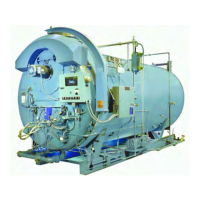Chapter 6 — Adjustment Procedures
Part No. 750-184 6-19
is approximately 20% excess air. The exact percentage of excess air
is a mathematical calculation based on an ultimate fuel analysis of
the fuel being fired.
It is generally recommended that O
2
readings of between 3% to 4%
be attained with less than 400 ppm CO, at high fire.
Using information from Section P of Chapter 6, determine the
standard conditions of gas pressure and flow for the size boiler and
the gas train on it. Calculate the actual pressure and flow through
the use of correction factors that compensate for incoming gas
pressure and altitude.
Basically, gas adjustments are made with a gas pressure regulator,
which controls the pressure, and with the butterfly gas valve (Figure
6-8) which directly controls the rate of flow.
In initially setting the linkage, back off the low fire stop screw on the
butterfly valve so that the valve is closed. Then run the screw out to
touch the arm, and give it two complete turns. Adjust the
connecting rod so that the override tension is released and so that
the arm is now just touching the stop screw. Tighten the locknuts
on all ball joints.
The low fire setting should be regarded as tentative until the proper
gas pressure for high fire operation is established.
To reach the high fire rate, turn the manual flame control switch
toward “OPEN” in minor increments while monitoring combustion
for overly rich or lean conditions.
Set and lock the high fire stop screw so that it is just touching the
valve arm.
Determine the actual gas flow from a meter reading. (See section P
of Chapter 6.) With the butterfly valve open and with regulated gas
pressure set at the calculated pressure, the actual flow rate should
be close to the required input. If corrections are necessary, increase
or decrease the gas pressure by adjusting the gas pressure regulator,
following the manufacturer's directions for regulator adjustment.
When proper gas flow is obtained, take a flue gas reading. The O
2
should be between 3% and 4% at high fire.
If the fuel input is correct, but the O
2
values do not fall within this
range, the air damper travel may need to be adjusted. Adjustment
of the air damper linkage is described in Section B of Chapter 6.
With the high-fire air/fuel ratio established, the gas pressure
regulator needs no further adjusting.
After being certain that the air control damper and its linkage are
correctly adjusted to provide the proper amount of combustion air,
and after adjusting the gas pressure regulator, final adjustment can
be made, if necessary, to the gas modulating cam to obtain a
constant air/fuel ratio throughout the entire firing range.
Note: Be sure the to loosen the cam foot locking screws
before adjusting any cam screws or the cam feet may be
damaged.
Figure 6-8 Butterfly gas valve
TO FOLLOWER OF
GAS MODULATING CAM
HIGH
FIRE
LOW
FIRE
BUTTERFLY GAS
VALVE ROD
OVERRIDE
SPRINGS
BUTTERFLY GAS
VALVE ARM
LOW FIRE
STOP SCREW
HIGH FIRE
STOP SCREW

